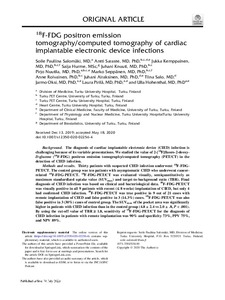18F-FDG positron emission tomography/computed tomography of cardiac implantable electronic device infections
Soile Pauliina Salomäki; Antti Saraste; Jukka Kemppainen; Saija Hurme; Juhani Knuuti; Pirjo Nuutila; Marko Seppänen; Anne Roivainen; Juhani Airaksinen; Tiina Salo; Jarmo Oksi; Laura Pirilä; Ulla Hohenthal
https://urn.fi/URN:NBN:fi-fe2021042826048
Tiivistelmä
Background. The diagnosis of cardiac implantable electronic device (CIED) infection is challenging because of its variable presentations. We studied the value of 2-[18F]fluoro-2-deoxy-D-glucose (18F-FDG) positron emission tomography/computed tomography (PET/CT) in the detection of CIED infection.
Methods and results. Thirty patients with suspected CIED infection underwent 18F-FDG-PET/CT. The control group was ten patients with asymptomatic CIED who underwent cancer related 18F-FDG-PET/CT. 18F-FDG-PET/CT was evaluated visually, semiquantitatively as maximum standardized uptake value (SUVmax) and target-to-background ratio (TBR). Final diagnosis of CIED infection was based on clinical and bacteriological data. 18F-FDG-PET/CT was visually positive in all 9 patients with recent ( ≤ 8 weeks) implantation of CIED, but only 4 had confirmed CIED infection. 18F-FDG-PET/CT was true positive in 9 out of 21 cases with remote implantation of CIED and false positive in 3 (14.3%) cases. 18F-FDG-PET/CT was also false positive in 3 (30%) cases of control group. The SUVmax of the pocket area was significantly higher in patients with CIED infection than in the control group (4.8 ± 2.4 vs 2.0 ± .8, P < .001). By using the cut-off value of TBR ≥ 1.8, sensitivity of 18F-FDG-PET/CT for the diagnosis of CIED infection in patients with remote implantation was 90% and specificity 73%, PPV 75%, and NPV 89%
Conclusions. 18F-FDG-PET/CT is a sensitive but nonspecific method in the diagnosis of CIED infection.
Kokoelmat
- Rinnakkaistallenteet [27094]
